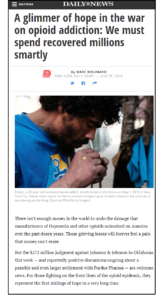
A glimmer of hope in the war on opioid addiction:
We must spend recovered millions smartly
by Dutchess County Executive Marc Molinaro
New York Daily News, August 29, 2019
There isn’t enough money in the world to undo the damage that manufacturers of Oxycontin and other opioids unleashed on America over the past dozen years. Those grieving losses will forever feel a pain that money can’t erase.
But the $572 million judgment against Johnson & Johnson in Oklahoma this week — and reportedly positive discussions ongoing about a possible and even larger settlement with Purdue Pharma — are welcome news. For those fighting on the front lines of the opioid epidemic, they represent the first inklings of hope in a very long time.
Money from the Johnson & Johnson settlement, and potentially the Purdue litigation, will invariably make its way to states, municipalities and counties like my own, Dutchess County, that filed suits against these irresponsible drug manufacturers for the damage they have caused. Not a dime of that money can be squandered. It must be spent responsibly and strategically to help preserve the lives of those struggling with opioid use disorders today.
If New York were to be awarded funds tomorrow, for example, that money should be distributed to communities in need and invested in proven strategies to reduce overdose deaths. A share of any New York funding should be used to create a local opioid response grant to provide funding to the local governments responsible for the direct provisions of services using a formula that calculates need based on both total opioid-related overdoses and the rate of opioid overdoses per 100,000 people.
But such grants must be contingent upon a local government having a plan to increase access to Medication-Assisted Treatment in its community, target vulnerable populations, incorporate harm-reduction principles and services and address other locally-identified issues (ex. data tracking, collaboration, barriers to treatment such as transportation, etc.).
A separate grant should be created to fund the expansion of MAT programs — specifically, buprenorphine — as well as pre-release planning and post-release follow up for opioid-involved individuals in local jails. One year after the Rhode Island Department of Corrections mandated and funded MAT programs in all correctional facilities statewide, overdose deaths dropped by 12% among the total population and 61% among those released from a correctional facility. Albany can learn from the Ocean State.
New York plays an equally vital role in the effort to end the opioid epidemic, and any future settlement funds could be used for additional, cutting-edge initiatives statewide. The Department of Health could expand efforts to aid physicians in becoming qualified to treat patients with opioid addiction. Funding could be provided to the Department of Corrections and Community Supervision to fund MAT programs in all of its prisons.
The state could use some settlement funds to increase outreach to emergency departments to ensure that they provide Narcan kits to patients in need and encourage them to initiate medication-assisted treatments, when appropriate. Studies have consistently shown those who receive an initial dose of buprenorphine — an approved treatment for opioid addiction — at the emergency room are more likely to continue treatment.
These are not novel ideas; local governments throughout New York, like Dutchess, are finding creative ways to help those affected by the opioid epidemic. New investment in both local and state initiatives will support current efforts, spur innovation, and allow for the further implementation of best practices across New York.
But for this to work, settlement funds cannot be used to offset current spending — and definitely not used to fill budget holes, as tempting as that might be down the road. We will have one chance to use this money responsibly, and we must take it. Too many have paid the price for it.

